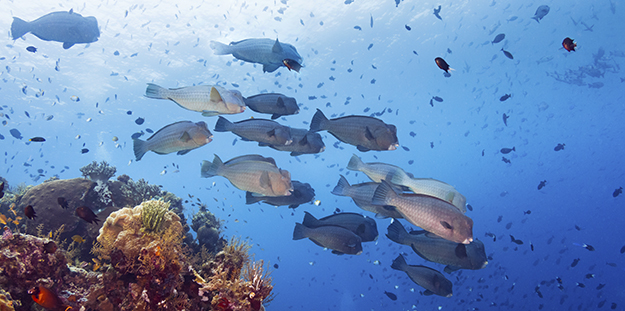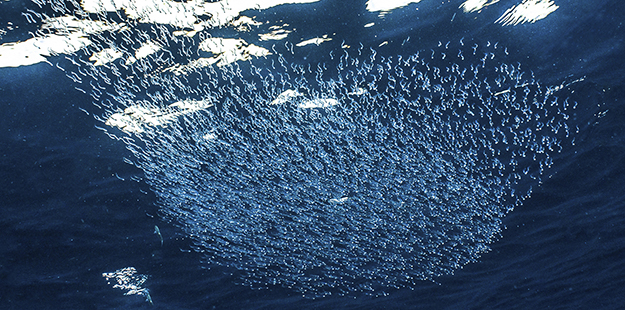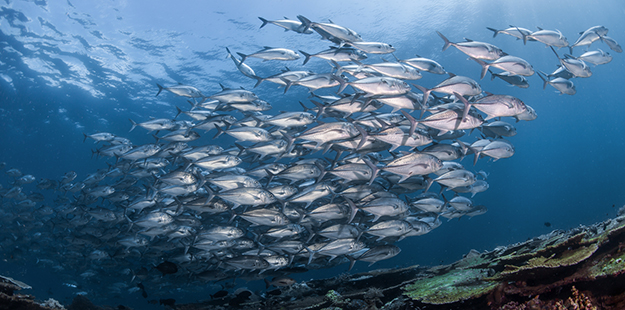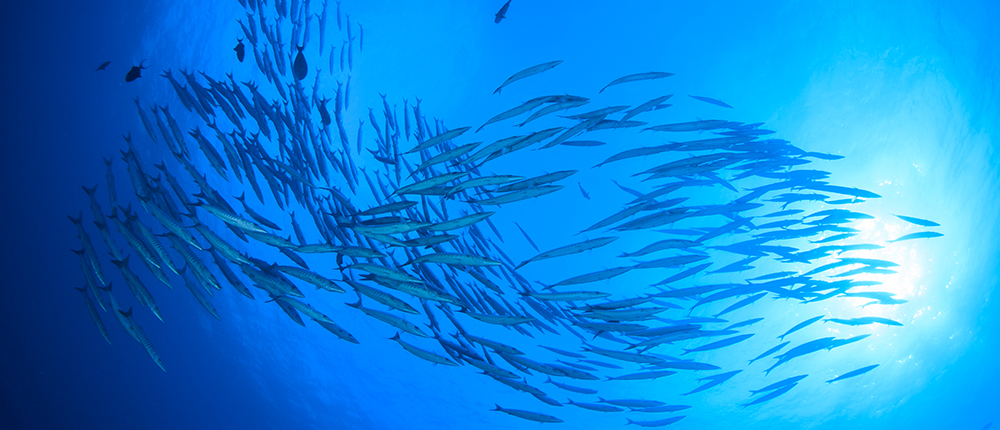School’s in Session
When a shoal appears to be more tight-nit and assembled in a coordinated pattern, it is known as a polarized shoal. You may notice types of shoals when fish are hovering stationary next something like a coral head, large sponge or sea fan. These groups will sometimes move slowly out into the open, but so long as they don’t move off in a specific direction, it’s still a shoal. Shoaling groups can sometimes include fish of disparate sizes, as well as include mixing with a second species as part of the whole group or as an associated subgroup. A good example of this can seen on Wakatobi’s dive site Zoo, where the site’s population of two-spot snappers and yellowfin goatfish will often join together in one polarized shoaling formation along the reef’s sloping face.

When bumphead parrotfish are on the move in schooling fashion they might suddenly spread out as an unstructured shoal in order to feed; then, regroup and move onward again. Photo by Walt Stearns
When school is in session
Technically, a shoal becomes a school when the fish in the group all decide they need to be somewhere else, and go on the move. To a diver, the differences between shoaling and schooling can be subtle, particularly when a shoal of fish can transition from an amorphous state suddenly into a disciplined and coordinated school, then back again in a matter of seconds. In its most classic form, a moving school will have a mission-oriented behavior, with all members of the school holding to a tightly-structured formation as they travel. To accomplish this coordinated movement, the fish don’t just rely on their vision, and instead tap into a sophisticated biological version of a collision avoidance system.

A common response among schooling fish under attack is to unify even further into a tightly packed, polarized mass, as seen with this school. Photo by Wayne MacWilliams
Schooling fish are equipped with a lateral line that running the length of their body. This line is highly sensitive to vibrations and pressure gradients produced by moving objects in the surrounding water. In addition to giving early warning of approaching predators or perceived threats such as inquisitive scuba divers, the lateral line provides each member of a fish school with a precise ability to track the location and movements of its neighbors without the need to see them. This ability takes on critical importance when a school receives an attack from one or more predators. A common response among schooling fish under attack is to unify even further into a tightly-packed and polarized mass. When this takes place, the fish in the center are not only blind to what is going on the outside, but also to where they going. They rely on information from their lateral lines to maintain the same speed, direction and position within their ranks.
The movements of a tightly-packed school of fish can be quite fascinating. Should the entire school suddenly need to reverse course, the transition between leaders and followers can be so fluid the school appears to function through a single collective mind. When a unified school of fish feels threatened or comes under attack, they may execute a rapid turn with sudden acceleration. When this happens, the synchronized motion of their tail sweeps will often produce a very audible pressure wave.

Species such as these trevallies stick together to avoid the risk of standing out as an easy target for predators. Photo by Marco Fierli, marcof8.com
Generally, when you see a school comprised of one species of fish they are likely all of the same size and age. Many biologists use the hypotheses known as the “oddity effect” to explain this phenomenon. It essence, by staying with schoolmates of equal size and appearance, no one individual runs the risk of standing out and presenting a more easily-recognized target, should a predator try to strike.
Learning to note the subtle patterns of fish schooling and shoaling will help you tune in to the goings on of the marine environment, and recognize shifts in behavior triggered by the need to feed, rest, breed, or avoid predation. In addition, the subject always makes for good conversation around the Wakatobi’s Jetty Bar at the end of the day.
It’s time to experience all that Wakatobi has to offer! Contact us at email office@wakatobi.com
Complete a quick trip inquiry at wakatobi.com
Visit us on Facebook.


